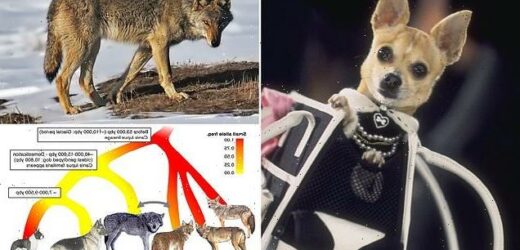Genetic mutation that makes some dogs including Chihuahuas and Pomeranians so small originated in WOLVES 53,000 years ago, study reveals
- The mutation was found by experts led from the US National Institutes of Health
- This was found in a reverse form of the insulin-like growth factor 1 (IGF1) gene
- It was thought that human-driven breeding was the sole cause for small dogs
- Yet the mutation evolved well before dogs were domesticated 20,000 years ago
The genetic mutation that makes dogs like Chihuahuas and Pomeranians so tiny first originated in wolves some 53,000 years ago, a study has revealed.
Researchers led from the US National Institutes of Health identified a mutation in a canine growth hormone-regulating gene that is associated with small body sizes.
The findings rebut the idea small dogs are the sole product of us breeding for small, cute companions in the wake of domestication 20,000 years ago.
The genetic mutation that makes dogs like Chihuahuas and Pomeranians so tiny first originated in big old wolves some 53,000 years ago, a study has revealed. Pictured: ‘Bruiser’ the Chihuahua in the 2001 comedy film ‘Legally Blonde’, with Reese Witherspoon’s Elle Woods
Researchers led from the US National Institutes of Health identified a mutation in a canine growth hormone-regulating gene that is associated with small body sizes. The team found that the mutation it was already present in the genetic code of a steppe wolf that lived in Siberia around 53,000 years ago. Pictured: a modern-day steppe wolf (Canis lupus campestris)
CANIDS EXPLAINED
The Canidae are a family of mammals which include dogs, coyotes, foxes and wolves, among others groups.
They are found on all continents except Antarctica, having traversed the globe either independently or by accompanying humans.
Typically social animals, canids range in size from the 6.6 feet (2 metre) -long grey wolf all the way down to the 9.4″ (24 centimetre) -long fennec fox.
The study — undertaken by geneticist Elaine Ostrander of the National Human Genome Research Institute and her colleagues — concludes a decade-long search for the genetic mutation underlying small body sizes in dogs.
Success came when the team searched for genetic sequences that were positioned backwards and were also present in other canids like wolves and also ancient DNA.
This approach yielded a reverse form of the insulin-like growth factor 1 (IGF1) gene, which was found to have variants that correlated with overall body size.
‘We looked at 200 breeds, and it held up beautifully,’ Dr Ostrander explained.
‘This is tying together so much about canine domestication and body size, and the things that we think are very modern are actually very ancient.’
In fact, when the researchers analysed samples of ancient wolf DNA to determine when the IGF-1 mutation first arose, the team found it was already present in the genetic code of a steppe wolf that lived in Siberia around 53,000 years ago.
‘It’s as though Nature had kept it tucked in her back pocket for tens of thousands of years until it was needed,’ said Dr Ostrander.
The researchers said that they also found the IGF-1 mutation in other members of the canid family — including African hunting dogs, coyotes and jackals.
With their initial study complete, the researchers are continuing their investigation into the genes that regulate body sizes in canines.
The researchers said that they found the IGF-1 mutation in other members of the canid family — including African hunting dogs, coyotes and jackals. Pictured: the distribution of the small body size mutation across different species of canids
The findings rebut the notion that small dogs are the sole product of human-driven breeding for small, cute companions (as pictured) in the wake of domestication 20,000 years ago
‘One of the things that is pretty cool about dogs is that — because they have evolved so recently — there aren’t actually a lot of body size genes,’ said Dr Ostrander.
In fact, canids only have 25, compared to the hundreds at play in us humans.
‘I really want to understand the whole continuum — from Chihuahuas to Great Danes,’ Dr Ostrander added.
The full findings of the study were published in the journal Current Biology.
DOGS WERE FIRST DOMESTICATED SOME 20,000–40,000 YEARS AGO
A genetic analysis of the world’s oldest known dog remains revealed that dogs were domesticated in a single event by humans living in Eurasia, around 20,000 to 40,000 years ago.
Dr Krishna Veeramah, an assistant professor in evolution at Stony Brook University, told MailOnline: ‘The process of dog domestication would have been a very complex process, involving a number of generations where signature dog traits evolved gradually.
‘The current hypothesis is that the domestication of dogs likely arose passively, with a population of wolves somewhere in the world living on the outskirts of hunter-gatherer camps feeding off refuse created by the humans.
‘Those wolves that were tamer and less aggressive would have been more successful at this, and while the humans did not initially gain any kind of benefit from this process, over time they would have developed some kind of symbiotic [mutually beneficial] relationship with these animals, eventually evolving into the dogs we see today.’
Source: Read Full Article






